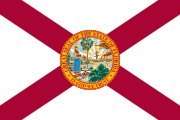Floridanos
 | |
| Religion | |
|---|---|
| Predominantly Roman Catholic |
Floridanos, also known as Los Floridanos, is a term for colonial residents of Spanish Florida as well as the modern descendants of the earliest Spanish settlers who lived in St. Augustine between 1565 and 1763, as well as those who lived in East and West Florida from 1780s, when Bernardo de Gálvez took back the Floridas from British hands and Spanish migration was promoted, to 1819. Some Floridanos can trace their ancestry in Florida back twelve or more generations. Descendants of the original Floridanos can be found throughout the state of Florida, including in St. Augustine and in Manatee County.[1]
History[]

Established on September 8, 1565, St. Augustine is the oldest continuously inhabited European settlement in what is now the United States.[2] Some of St. Augustine's Spanish settlers left Florida during the time that the British ruled East Florida, with many moving to Cuba. Approximately 3,000 Floridanos left Florida for Havana, Cuba between 1763 and early 1764. Spanish Floridians in western Florida mostly fled to Veracruz, Mexico, with about 620 sailing from Pensacola.[1] The term "Floridano" was the term used by the Spanish colonial authorities to designate Spanish Floridian immigrants to Cuba.[3] Floridas were reconquered by Bernardo de Galvez and the new governors of both provinces promoted Spanish migration to them. The Floridas were ceded to the USA in 1819, by the Adams–Onís Treaty. As in 1763, many Floridanos migrated to Cuba. Because of this, some Cuban-Americans in Florida can also trace their ancestry back to colonial Florida.
In 2010, an historical marker titled "Los Floridanos" was unveiled at St. Augustine's Visitor Information Center that commemorates the Floridanos.
Notables[]
- Martín de Argüelles (1566-1630) First white child (criollo) known to have been born in what is now the United States. His birthplace was St. Augustine, Florida.
- Luis Cáncer, Dominican priest
- Juan de Ayala y Escobar, governor of Spanish Florida (1716 - 1718) and a resident of that province.
- Hernando de Escalante Fontaneda, Spanish shipwreck survivor who lived among the Native Americans of Florida for 17 years.
- Joseph Marion Hernández (1788 - 1857), Floridano who served as the first delegate from the Florida Territory. He was also the first Hispanic American to serve in the United States Congress and a member of the Whig Party (1822 - 1823)
- Pedro Benedit Horruytiner, interim co-governor of Spanish Florida (1646 - 1648) and governor of Spanish Florida (1651 - 1654). A resident of that province, his house and library are still preserved in Saint Augustine.
- Francisco Menéndez Márquez, interim co-governor of Spanish Florida (1646 – 1648), and the founder of the largest cattle ranching enterprise in Florida.
- Tomás Menéndez Márquez (1643–1706), official in the government of Spanish Florida, and owner, with his brothers, of the largest ranch in Spanish Florida.
- Nicolás Ponce de León II, acting governor of Spanish Florida (1663 - 1664, and 1673 - 1675) who was a native of Saint Augustine.
- Eligio de la Puente (1724–1781), Floridano who held various public offices in St. Augustine, Florida and in Havana, Cuba during the 18th century.
- Agustín V. Zamorano (1798–1842), Floridano who served as governor of Alta California (1832 - 1833).
See also[]
References[]
- ^ a b James A. Jones Jr. (2015-09-05). "Manatee's 'Los Floridanos' to attend 450th anniversary reunion in Saint Augustine". Bradenton Herald. Retrieved 2021-10-05.
- ^ "Florida Frontiers "Floridanos, Menorcans, Cattle-Whip Crackers: Poetry of St. Augustine"". The Florida Historical Society. Retrieved 2021-10-05.
- ^ "Identifying los floridanos was important task". The St. Augstine Record. Retrieved 2021-10-05.
External links[]
- Cuban-American culture in Florida
- Spanish-American culture in Florida
- Spanish Florida
- Spanish-Cuban culture
- Spanish-Mexican culture